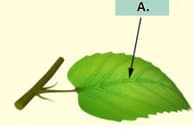Nutrition
Nutrition: Overview
This topic covers concepts, such as, Nutrition, Autotrophic Nutrition, Large intestine & Salivary Glands etc.
Important Questions on Nutrition
The A, B and C are three living organisms. The organism A is a unicellular fungus which can live without air. It is used in the commercial production of an organic compound P from molasses. The organism B is a unicellular animal which lives in water and feeds and moves by using pseudopodia. It breathes through an organelle Q. The organism C is a tiny animal which acts as a carrier of the malarial parasite. It breathes and respires through a kind of tiny holes R and air-tubes S in its body.
What is organism B and organelle Q?
Match the organisms given in column I with the processes given in column II.
| Column I | Column II |
| (i) Leech | (a) Holozoic nutrition |
| (ii) Amoeba | (b) Autotrophic nutrition |
| (iii) Mushroom | (c) Parasitic nutrition |
| (iv) Green plant | (d) Saprophytic nutrition |
Assertion: Haemoglobin contains iron.
Reason: Iron deficiency leads to anaemia.
What represents by the label A in the given picture?
Leaches are mostly ectoparasites, but few are predators.
Saliva of leeches contain an anticoagulant, called as _____ (hirudin/heparin/histamine).
How the transportation of material is different for xylem (X) and phloem (P)?
Draw the cross-section of a leaf and label the xylem and phloem.
Write two functions of vascular bundles that helps plants to survive and grow.
Lice show symbiotic association with _____ (bacteria/virus).
Leaf veins maintain _____ (water potential/turgor pressure).
Veins allow us to measure photosynthetic capacity.
Select the incorrect statement about the leaf vein.
In the cytoplasm of the Amoeba, the food vacuoles fuse with ribosomes for the digestion of food particles.
Explain how does the presence of a cuticle layer on the different parts of cactus plants be advantageous.

